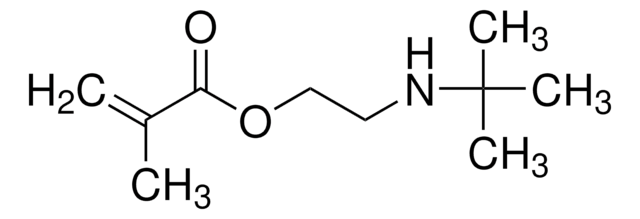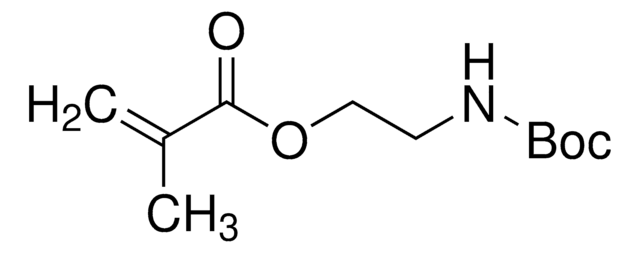408980
2-(Diethylamino)ethyl methacrylate
contains 1500 ppm MEHQ as inhibitor, 99%
Synonyme(s) :
β-(Diethylamino)ethyl methacrylate, 2-(N ,N -Diethylamino)ethyl methacrylate
About This Item
Produits recommandés
Pureté
99%
Forme
liquid
Contient
1500 ppm MEHQ as inhibitor
Indice de réfraction
n20/D 1.444 (lit.)
Point d'ébullition
80 °C/10 mmHg (lit.)
Densité
0.922 g/mL at 25 °C (lit.)
Chaîne SMILES
CCN(CC)CCOC(=O)C(C)=C
InChI
1S/C10H19NO2/c1-5-11(6-2)7-8-13-10(12)9(3)4/h3,5-8H2,1-2,4H3
Clé InChI
SJIXRGNQPBQWMK-UHFFFAOYSA-N
Catégories apparentées
Application
- Polymeric mediator containing ferrocene moieties which are applicable in electrochemical biosensors.
- Sepiolite-based nanocomposites by (cryo)polymerization method.
- Thermoresponsive triblock copolymers via group transfer polymerization (GTP).
Mention d'avertissement
Warning
Mentions de danger
Conseils de prudence
Classification des risques
Acute Tox. 4 Inhalation - Eye Irrit. 2 - Skin Irrit. 2 - Skin Sens. 1
Code de la classe de stockage
10 - Combustible liquids
Classe de danger pour l'eau (WGK)
WGK 1
Point d'éclair (°F)
170.6 °F - closed cup
Point d'éclair (°C)
77 °C - closed cup
Équipement de protection individuelle
Eyeshields, Faceshields, Gloves, type ABEK (EN14387) respirator filter
Certificats d'analyse (COA)
Recherchez un Certificats d'analyse (COA) en saisissant le numéro de lot du produit. Les numéros de lot figurent sur l'étiquette du produit après les mots "Lot" ou "Batch".
Déjà en possession de ce produit ?
Retrouvez la documentation relative aux produits que vous avez récemment achetés dans la Bibliothèque de documents.
Les clients ont également consulté
Notre équipe de scientifiques dispose d'une expérience dans tous les secteurs de la recherche, notamment en sciences de la vie, science des matériaux, synthèse chimique, chromatographie, analyse et dans de nombreux autres domaines..
Contacter notre Service technique
![N-[3-(Dimethylamino)propyl]methacrylamide 99%, contains MEHQ as inhibitor](/deepweb/assets/sigmaaldrich/product/structures/295/145/6b4aae15-7cb5-4b7b-9c06-8e6d24e50951/640/6b4aae15-7cb5-4b7b-9c06-8e6d24e50951.png)


![[2-(Methacryloyloxy)ethyl]trimethylammonium chloride solution 75 wt. % in H2O](/deepweb/assets/sigmaaldrich/product/structures/316/612/66b0f4cf-d060-427d-b4f5-e8fab3e5cffe/640/66b0f4cf-d060-427d-b4f5-e8fab3e5cffe.png)



![[2-(Methacryloyloxy)ethyl]dimethyl-(3-sulfopropyl)ammonium hydroxide 95%](/deepweb/assets/sigmaaldrich/product/structures/217/219/73c91e1c-0ee4-4b3d-bead-a6dc3d09d1da/640/73c91e1c-0ee4-4b3d-bead-a6dc3d09d1da.png)








